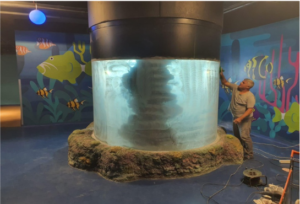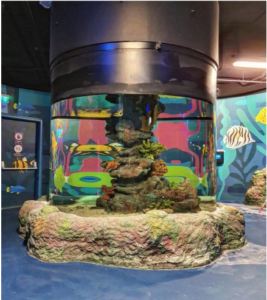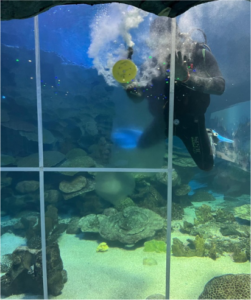The colorless transparent acrylic sheet has a light transmittance of around 92% and offers a clearer view than glass. Therefore, even the smallest scratches are clearly visible. Dry-scratched acrylic surfaces should not be sanded unless the imperfections are deep enough to be removed by abrasive polishing and buffing. If sanding is necessary, it should be done carefully and without burning the acrylic surface.
In dry area and underwater acrylic polishing processes, the depth of the scratches is first determined. According to the depth of the scratches, the number of sandpaper to start the sanding process is selected. In the first stage, coarser sandpaper is used and this process continues gradually with finer sandpaper. At each stage, the surface becomes smooth and scratch-free. Finally, polishing is applied to restore the gloss of the acrylic surface. In this way, the acrylic sheet becomes visually clearer and its durability is increased.
Underwater acrylic polishing is the process of smoothing and polishing the surface of acrylic materials used in underwater structures (e.g. underwater glass, acrylic aquariums, diving glass). This process aims to improve the aesthetic and functional properties of the acrylic material. The harsh conditions in the underwater environment can have negative effects on acrylic surfaces such as contamination, abrasion, scratching and dulling. The polishing process minimizes such problems, enhancing both the visual appeal and durability of the material. As a result, underwater acrylic materials become clearer, transparent and long-lasting.
Benefits of Underwater Acrylic Polishing:
Aesthetic Improvement: The polishing process improves the appearance of transparent materials, such as underwater glass, by increasing the gloss and transparency of the acrylic material. This is a significant aesthetic benefit because it provides a clean and crisp appearance.
Increased Durability: Removing scratches and roughness from the surface makes the material more durable. This helps the material to last longer under the harsh conditions encountered in an underwater environment.
Easy Cleanability: The polishing process increases the resistance of the acrylic surface to dirt, algae and other foreign substances. This makes the surface easier to clean, reduces maintenance costs and ensures long-term hygiene.
Underwater acrylic polishing plays a critical role in the maintenance of acrylic materials, especially those used in diving glass, underwater aquariums and subsea structures. This process prolongs the life of the material and provides a more aesthetically pleasing and clearer appearance.
Aesthetic Enhancement: Polishing improves the appearance of transparent materials such as underwater glass by increasing the gloss and transparency of the acrylic material. This is a significant aesthetic benefit because it provides a clean and crisp appearance.
Increased Durability: Removing scratches and roughness from the surface makes the material more durable. This helps ensure the longevity of the material under the harsh conditions encountered in an underwater environment.
Easy Cleanability: The polishing process increases the resistance of the acrylic surface to dirt, algae and other foreign substances. This makes the surface easier to clean, reduces maintenance costs and ensures long-term hygiene.
Underwater acrylic polishing plays a critical role in the maintenance of acrylic materials, especially those used in diving glass, underwater aquariums and subsea structures. This process prolongs the life of the material and provides a more aesthetically pleasing and clearer appearance.








